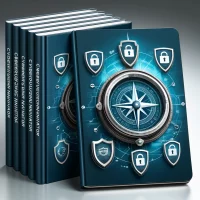In the collaborative spirit of our recent partnership, I had the opportunity to delve into “The Art of Cyber Defense.” This book is not merely a technical guide; it is a compelling narrative that stitches together the critical threads of cybersecurity and business management.
“The Art of Cyber Defense” strikes a remarkable balance between being insightful and accessible, making it an essential read for business leaders and IT professionals alike. The author leverages expertise to demystify the complex world of cyber threats while simultaneously offering practical strategies that resonate well beyond the IT department.
One of the book’s notable strengths is its strategic framework, which doesn’t just skim the surface of standard security protocols but dives deep into how these practices underpin broader business objectives. The author excels in making cybersecurity a tangible aspect of business strategy, which is particularly enlightening. It’s not just about protecting assets but enhancing operational efficacy and fostering a secure corporate culture.
Throughout the book, practical insights come to life through real-world examples and case studies, illustrating how sophisticated cybersecurity strategies can protect and even enhance business value. This practical angle is not just educational but deeply motivational, urging leaders to act proactively in their cybersecurity initiatives.
What I appreciate most about “The Art of Cyber Defense” is its accessibility. The author breaks down complex cybersecurity jargon into language that is understandable for non-technical business leaders. This facilitates a deeper understanding of critical cyber defense mechanisms without oversimplifying the technical depth.
Each chapter concludes with actionable steps, a feature that I found particularly useful for implementing the discussed strategies. This structured approach helps demystify the often overwhelming field of cybersecurity, making it approachable for executives and managers who may not have a technical background.
In reviewing “The Art of Cyber Defense,” it’s clear that the author has crafted a comprehensive guide that addresses the multifaceted challenges of today’s digital threats with a keen understanding of business imperatives. This book is a must-read for those looking to step up their cybersecurity game in alignment with their business strategies.
I invite all of you, whether you’re at the helm of a startup or steering a large corporation, to consider how the integration of cybersecurity can drive your business forward. Let’s move beyond seeing cybersecurity as a mere line of defense and towards embracing it as a core component of business success.
An Interview with the Author
Thank you for joining us today. To start off, could you share what motivated you to write “The Art of Cyber Defense” and what you hope readers will take away from it?
Author: Thank you for having me. The primary motivation behind writing this book was to bridge the often wide gap between cybersecurity as a technical field and its strategic importance to business management. I’ve observed that many leaders view cybersecurity measures as a checkbox to tick rather than an integral part of their strategic operations. My hope is that readers will come away with a clear understanding of how closely intertwined cybersecurity and business success truly are, and how they can use this to their advantage.
In your book, you discuss the evolving nature of cyber threats. Could you explain how businesses can stay ahead of these changes without being overwhelmed by the complexity and rapid development of digital threats?
Author: Absolutely, staying ahead of cyber threats means fostering a culture of continuous learning and adaptation within the organization. Businesses need to invest in regular training and development for their IT teams and also for their general staff, as everyone plays a role in cybersecurity. Additionally, adopting a proactive cybersecurity stance—anticipating potential security challenges and addressing them before they become issues—is crucial. This involves not only investing in the right technology but also in strategic planning and execution.
Many business leaders struggle with the technical aspects of cybersecurity. How does your book help non-technical senior executives understand and manage these risks effectively?
Author: That’s a great point. I aimed to demystify the technical jargon that often alienates non-technical stakeholders. The book uses plain language and practical examples to explain concepts. It also provides actionable advice that executives can implement, regardless of their technical expertise. By framing cybersecurity issues within the context of business impacts—such as risk management, legal compliance, and brand reputation—I hope to make it more accessible for leaders from all backgrounds.
Cybersecurity is often seen as an IT issue, but you argue that it should be a boardroom priority. How can companies integrate cybersecurity into their core business strategy?
Author: Cybersecurity should be a key component of overall business strategy, not an afterthought or only a concern for the IT department. It starts with education at the highest levels—ensuring that those in the boardroom understand the potential business impacts of cyber threats and the strategic value of robust cybersecurity measures. From there, it’s about integrating these considerations into the business planning process, similar to any other strategic initiative. This integration can be facilitated by regular risk assessments, clear communication between IT and management, and involving senior leadership in cybersecurity decision-making processes.
Finally, for companies just beginning to take cybersecurity seriously, what first steps do you recommend to effectively jumpstart their cybersecurity initiatives?
Author: The first step is always to assess your current situation. Understand where your vulnerabilities lie and how they could potentially impact your business. This might involve conducting a comprehensive cybersecurity audit. From there, prioritize the areas of highest risk and begin addressing them with both technical solutions and policy updates. It’s also important to appoint a dedicated cybersecurity leader—whether that’s a CISO or another role—that can drive these initiatives forward. Starting with these foundational steps will help ensure a solid base upon which to build more complex cybersecurity strategies.
Multilingual Availability of “The Art of Cyber Defense”
Whether you’re a native speaker of Catalan, Spanish, Danish, German, Finnish, French, Hindi, Italian, Portuguese, or Swedish, you can now access this invaluable resource in your language. This expansion ensures that the crucial insights and strategies discussed in the book are accessible to a diverse range of business leaders and cybersecurity professionals across the world, promoting better cyber defense practices internationally.
Part of the “Cybersecurity Leadership Mastery” Series
“The Art of Cyber Defense” is a proud part of the “Cybersecurity Leadership Mastery” series, which also includes “Leadership in Cybersecurity,” “Incident Response Leadership,” and “CISO Essentials.” This series is designed to empower current and aspiring cybersecurity leaders by providing comprehensive insights into managing digital threats effectively, leading incident response teams, and mastering the essentials needed for a Chief Information Security Officer. Each book in the series builds on the others, offering a holistic approach to mastering the complexities of cybersecurity leadership in today’s digitally-driven world.



















